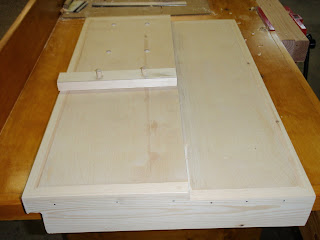Introduction
This is the initial post for the new blog and I think it appropriate to begin, not with the construction of an actual instrument, but with a discussion of what are often considered necessary aids for building a 'proper' mandolin. So, I will attempt to describe a few forms/jigs, patterns and 'tools' that I have made in order to facilitate construction.
The first build to be documented on this blog will be a very, very nice Octave Mandolin kit that I purchased from Luthier Don Kawalek of Bunker Hill, West Virginia. Therefore, much (but not all) of what I will describe below pertains to the building of Don's kit.
The Mandolin Form
The idea for the form comes from Graham McDonald’s excellent book, ‘The Mandolin Project’. To begin with, I dry clamped the tail and neck blocks to the sides, and then traced the pattern onto a piece of 3/4" MDF to get the exact shape of the body. Don's kit came with a full set of plans and I made a pattern from it, but I decided instead to trace the sides to get it as close to the pre-bent specs as possible.
The picture above actually shows me double checking the shape with the soundboard, but you need only do the same thing on a piece of plywood or MDF. After the shape was traced I then made an 'S' shaped cut in the MDF, using the band saw, directly above where the neck block will be positioned, to cut out the body shape in the interior. Once completed, I attached a hasp outside of the 'S' cut, in order to be able to lock it tight while holding the sides. This was also done so that I would be able to loosen the form from the body after the soundboard and/or back is glued on. Then two pieces of pine dimensioned 3/4"x1 1/2" x 18" were glued and nailed to the sides of the form (I drilled pilot holes for the nails before gluing). When sanded, the form (with sides, neck and tail block inserted) looks like this:
You can just barely see the hasp on the outside of the form on the left side of the picture, near the bottom of the cam clamp. Also note that I ripped the cutout to about a third of its original size, drilled out a mortise in each piece so that they would accept a turnbuckle. Tightened, this will help keep the sides flush against the form. Be sure to draw a centerline on the form so that you can easily lineup the center of the neck and tail block.
Here the only real difference is that instead of using a hasp to lock the form I've bolted a piece of 3/4" pine to both the top and bottom of the form to lock and unlock it. Either way works fine. It just depends of which method you prefer more.
And one more shot of the variation, with a mock-up top sitting on the sides while in the form:
And one more shot of the variation, with a mock-up top sitting on the sides while in the form:
15’ Radiused Sanding Dish & the Jig to Accompany It
This dish is used for sanding the sides before gluing the soundboard or back while they are in the mandolin form. The idea is also found in McDonald’s book. He says to cut a 17” diameter circle out of 3/4" MDF on the band saw, to which are glued 2"x1" pine strips (or other wood that you might have handy . . . I just used scrap 2"x4"s for mine), which are tapered from 3/8" to 3/16". Once glued, an 1/8" peice of 17" diameter plywood is glued to on top of the strips. Here you can see the strips glued to the MDF:Here is the 1/8" ply glued to the strips:
Double-sided tape added to the ply & then sand paper stuck to the tape:
You will notice that I've drilled a hole in the center of the dish. This is meant to take a dowl that will be used to keep the dish centered in the mandolin form when sanding the sides.
Meant to be used along with the sanding dish and the mando form is a very simple jig to hold the form. It is made out of a 20"x24" piece of MDF and a 17" 2"x"4 glued and screwed to the bottom center so it can be clamped into the vice. On each side I routed two slots for holding 'clamps' made from a 3/4" disk and hex bolt, a washer and wing nuts (see the discussion on Spool Clamps below for more info). The second picture below show the hole drilled in the 'center' of the jig to hold the dowl and sanding dish. Here are a few pictures of it:
In this last photo you can see the dowl placed in the hole drilled into the jig, and holding the sanding dish. It is very simple, but really works well (N.B., you can move the mando form left or right if you need to 're-center' the sanding dish)!
Spool Clamps
These are used when clamping the back and soundboard to the sides. They are very simple to make, and it is definitely worth the money to construct them yourself if you have a little free time. To make them you will need a scrap piece of relatively clear ¾” pine, a 1 ¼” hole saw chucked in a drill press (or in a hand drill) in order to cut two disks per clamp, 5 ½” x ¼” hex head bolts, two washers per clamp, and a wing nut per clamp. I cut the disks out on the drill press, sanded them, put a coat of shellac on each, and then assembled the clamps. (N.B., some people put felt or cork on the insides of the disks to protect the soundboard/back from the clamping surface. I've found that if they are not 'overclamped' you can skip that step. But, feel free to add either if you are worried.) Here are some shots, which are hopefully self-explanatory:The Shooting Board
The shooting board is probably almost as old as carpentry. It has been discussed a million times in books on woodworking, hand tools, joinery, et.al. So, I won’t even attempt to describe, in great detail, something that others have already described so well. For those of you who might be unfamiliar with the shooting board, it is an indispensable tool for people who like to use handplanes ( . . . that would be me :) – especially when trying to square up book matched soundboards or backs, or thicknessing and/or dimensioning them. Mine is simply two pieces of ¾” plywood glued together at an offset. I then ‘trimmed it out’ with pine, making sure to put a ‘bench hook’ on the end nearest me. The pine trim was pre-drilled with pilot holes, glued, and then nailed on. I also have a stop on the top that holds the wood that I am working. It is held in place by two ½” dowels that fit into recessed holes drilled into the top. You don’t have to do this, but it is nice when working with shorter pieces of wood. Here are some pics, which are hopefully (like the clamps) self-explanatory:
The picture below shows the 'bench hook', so you have a sense for the underside of the shooting board. I hope some of this has been helpful.




















No comments:
Post a Comment